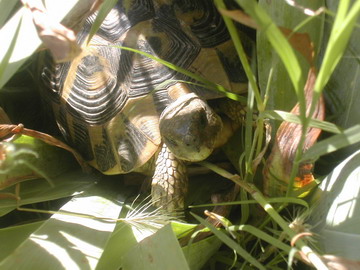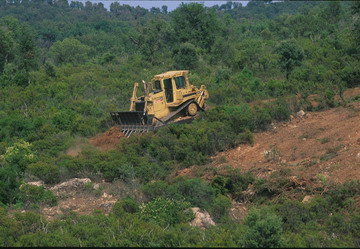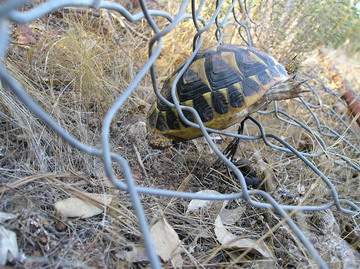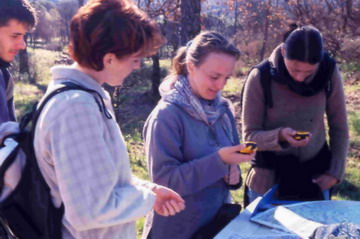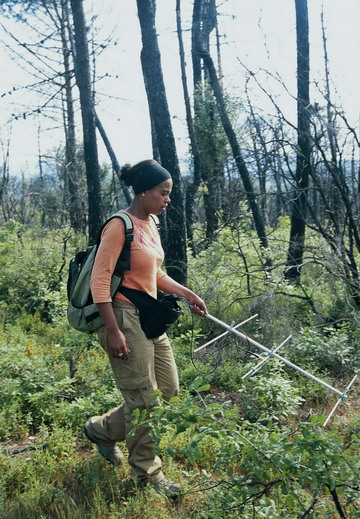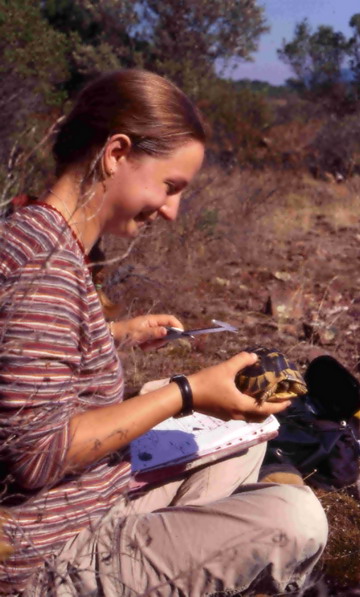J. Giraudo and T. Hermans – SNPN (Société Nationale de Protection de la Nature) snpn{at}wanadoo.fr
M. Cheylan – EPHE (Ecole Pratique des Haures Etudes de Montpellier) cheylan{at}univ-montp2.fr
B. Livoreil – CRCC (Centre for Research and Conservation of Chelonians) / SOPTOM blivoreil{at}aol.com
A. Catard – CEEP (Conservatoire Etudes des Ecosystèmes de Provence) catard{at}libertysurf.fr
A. Cadi – Noe Conservation – acadi{at}noeconservation.org
In 1991, the Standing Committee of the Bern Convention (Council of Europe), in its 26th recommendation, urged France "... to protect Testudo hermanni hermanni’s habitat in the massif and plain of the Maures by creating a Nature Reserve to preserve it permanently from the dangers related to development, to foster a captive breeding and reintroduction programme and protect the habitat of the richest Corsican populations". In a previous article, Barbara Livoreil (1993), after having underlined the difficulties involved in the first reintroduction programmes, stressed the urgent need to protect the habitat of Testudo hermanni. We would now like to assess the dangers facing the last core populations of this species and the protection measures in place, particularly in the Plaine des Maures which is the animal’s most important habitat in mainland France, both in area (5000–7000 hectares) and in population (between 1/4 and 1/6 of the total population; Cheylan, 1992).
Fifteen years on, the future of Hermann's tortoise remains quite uncertain. The protection measures being put in place are not really suited to the species distribution, and the restoration plan which has been pending since 1996 is still not in force. Nevertheless, on the ground, a lot has been done and positive partnerships have been developed so we believe that there is still hope of saving the last wild populations.
HERMANN’S TORTOISE
Today Hermann’s tortoise is one of Europe’s most endangered reptiles (see centrefold, Colour Plate I). Its numbers have continued to decrease dramatically over the past few decades in all of its range, which originally spread from eastern Spain to Italy. Its scarcity is mainly due to shrinking habitat caused by a decline in traditional methods of agriculture, forestry and grazing, in addition to forest fires, tortoise collecting and mechanical land clearance.
In mainland France only five population cores are still to be found in Provence (Le Var). Recent inventories made in 1993–2003 (Cheylan, 2004) and 2001–2005 (CRCC/SOPTOM, yet to be published) confirm this erosion of the continental distribution area and the disappearance of marginal pockets of low density. Luckily, it seems that high density populations have been able to maintain their numbers.
THE PLAINE DES MAURES
The Plaine des Maures is undoubtedly one of the most remarkable natural sites in Provence. Forming a geographical entity with the Massif des Maures (a small mountain range whose peaks form its southern limit) it is bordered by limestone hills in the north and west. This magnificent landscape is often compared to the African savannah and is unique in France and Western Europe. Parasol pines amid pink sandstone outcrops and sparse cork oak scrubland are set against the blue background of the Massif des Maures. The unusual Permian geomorphology and climatic conditions within the Plaine des Maures have formed a unique collection of ecosystems which are home to a rich array of fauna and flora: 45 protected plant species (including 23 on a national basis – a record on French territory); exceptional insect fauna; 134 bird species observed (the site is an ‘important bird area in Europe’); 22 species of amphibians and reptiles; and 16 species of bats.
However, this vast area of undeveloped land, just 20 km from St Tropez, is extremely desirable for development. In recent years there has been substantial residential building on the periphery and a motorway was constructed in the late 1980s. The Plaine des Maures covers 13,000 hectares but only remains in its natural state on approximately 6,000 hectares. Enormous pressure continues from urbanisation, agricultural growth, building developments for tourism and major infrastructural projects.
Hermann’s tortoises occur in a great variety of habitats in the Plaine des Maures: grasslands; heather and rock rose scrubland; pine forests and sparse cork oak forest. In the outlying areas where vineyards prevail, the interstitial woodland, hedges and fallow are very suitable to the tortoise. In the wilder central zones, old wood formations with well developed heather, and grasslands with layers of bushes and sparse trees, shelter the highest numbers. However, the tortoise’s presence is not assured in these areas as it has often been eradicated by fires. In the south and east of the Plaine des Maures the tortoise densities are average to low (hourly sighting rates of less than 1 tortoise/hour) whereas in the north and west they are average to high or even very high (hourly sighting rates of 1.5 tortoises/hour, often higher than 2 and, in certain localities, exceeding 5). This uneven distribution makes protection particularly difficult, as outer sectors, where the tortoise is abundant, are also subject to pressure from developers.
THE MAIN CAUSES OF THE DECLINE OF HERMANN’S TORTOISE IN THE PLAINE DES MAURES
Habitat modification: Increasing residential development and tertiary activities have caused major divisions in tortoise populations. Surviving pockets are vulnerable. Their capacity to recover their numbers does not compensate for losses caused by forest fires, collecting, clearing accidents, etc.
Forest fires: Fires are responsible for high tortoise mortality, varying from 75 – 85 % of the numbers. In France, fires have eradicated entire populations of Hermann’s tortoise (Albères, Esterel, Corbières) and greatly weakened others (Colle du Rouet, Maures). The Plaine des Maures has also been seriously affected (3411 hectares since 1979).
Collecting: Although commercial collecting appears to have ceased, casual collecting persists and has probably increased. This is due to easier human access into forests facilitated by the development of roads designed to help in fire fighting and the advent of four-wheel drive vehicles and mountain bikes. Despite years of campaigning by the SOPTOM and other organisations to educate the public, the tortoise is still perceived as a semi-domestic animal that is more suited to a garden than the wild.
Mechanisation of clearances for fire prevention: Each year, many tortoises fall victim to the machines used to clear land for firebreaks. Paradoxically, once cleared, for three to five years a firebreak makes highly valuable fallow land which tortoises prefer to the denser wooded areas of their habitat, thus possibly increasing the risk of accident. Although preferable, winter clearing, which has been carried out for the last few years, is not the panacea, as tortoises bury themselves lightly during hibernation and can be crushed under the weight of the machines. Manual clearing, by far the better solution, costs approximately 1500€ per hectare compared with 800€ for mechanical clearing.
Land clearance for vineyards: Until recently, wine-growing in the Plaine des Maures was not intensive and allowed open areas beneficial to the natural environment (firebreaks, forest edges) to be maintained. It is now expanding due to the development of AOC wine. Most of the vineyards producing the well-known, commercially successful Rosé de Provence are now owned by large private companies. With industrial techniques, small parcels of land are amalgamated into large, open, vineyards, destroying hedges and interstitial woodland. The land clearance has also put strong pressure on the tortoise’s habitat, both in terms of area and of compartmentalisation, from 10 hectares between 1988 and 1998 to 52 hectares between 1998 and 2003 (SNPN estimation). Although unauthorised land clearance, which was common until 2003, has been banned, the practice of transferring planting rights still affects important areas.
THREATS TO THE PLAINE DES MAURES
Urbanisation: The villages on the outskirts of the Plaine des Maures have grown considerably since the 1970s and demographic growth has led inevitably to increasing urbanisation. Recent changes in urban planning legislation should restrict building and favour agriculture or the natural environment. Unfortunately these changes have had unexpected consequences. Due to the tremendous price difference between vineyards and building land, wine-growers who had vineyards within urban zones are compensated with alternative land in the natural areas. A record increase in the Var population is forecast over the next 20 years, representing a serious threat to the tortoise populations situated in the outskirts of the plain which are not included in protective measures.
The Bouis golf project: Golf courses are proliferating in southern France as they often allow large commercial developments under the guise of environmentally friendly projects. The ZAC of Bouis, the biggest in France with more than 1,160 hectares, was established in the late 1970s and was designed to house the biggest golf complex in Europe. Between 1987 and 1991 unauthorised clearing was undertaken, followed by the construction of a 60 hectares golf course and a 5,000 m² show village. These breaches of the law have been the subject of numerous lawsuits pursued by APEVV (Association pour la Protection de l’Environment de Vidauban et du Var, a local association) and SNPN. In addition, an area of approximately 100 hectares has been enclosed, creating a barrier to animal movement. However, in 2004 the civil courts required the owners of the Bouis golf project to restore the site to its original natural state. The promoters lodged an appeal. Then, in March 2006, the annulment of the ZAC was obtained in the Administrative Court of Nice. As yet, neither the Mayor nor the promoters has appealed against this judgement. In environmental terms, the consequences of these decisions are considerable and signal the restoration of approximately 100 hectares of natural land.
The Balancan landfill: This private waste disposal centre was opened in 1974 and despite opposition from environmentalists the site has regularly expanded. Today it covers an area of 20 hectares (6 million tons of waste from a population basin of 300,000 inhabitants). Following pressure from the Council of Europe, the French authorities have recently rejected the development of a new site over a 20 year period, on 24 hectares with a high tortoise density. Nevertheless, due to the lack of an alternative solution, a fourth site will be authorised on a few hectares situated between existing degraded areas for a 5 year period. Local environmental associations believe that 5 years is too long as this would simply allow the company and politicians to play for time. If efforts were made it should be possible to find a solution in two or three years at the most.
High Speed Train Line Project – Ligne à Grande Vitesse pour la région Provence-Alpes-Côte d'Azur (LGV PACA): This old project resurfaced in 2005 when a public debate was held. The cost of the new line is estimated at 7 billion euros for a time gain of 75 minutes for passengers travelling between Paris and Nice. It is highly contentious on economic grounds, for its lack of benefit to local populations and its incompatibility with freight transport. The environmental consequences are also extremely negative as thousands of hectares of countryside would be destroyed between Marseille and Nice, and, although several routes are to be studied, every one of them would pass through the Plaine des Maures, splitting the territory in two and causing irreparable damage to this natural sanctuary and the numerous rare species including Hermann’s tortoise who depend on it for their survival. Once again local associations are mobilising their efforts to fight a project that, if it came to fruition, would act as a catalyst for further urbanisation and development (property speculation, population increase and a possible future airport).
PROTECTION OF THE HABITAT OF HERMANN'S TORTOISE
A major environmental battle was fought in the early 1990s over a proposed Michelin tyre testing centre in the core of the Plaine des Maures. It resulted in the transfer of the project to an alternative site. Following this, a Projet d'Intérêt Général (PIG) was set up in 1998 on 18,000 hectares. This temporary preservation measure had very little beneficial effect on the habitat of Hermann’s tortoise but allowed for the necessary changes in local land plans while permanent preservation measures were instigated.
Natura 2000 site: The Natura 2000 site includes 6,226 hectares. The official Document of Objectives (DOCOB) should be available in 2006. This Natura 2000 document describes the environmental stakes and the management suggestions and rules for the site. Unfortunately, the site covered only the wild natural habitats in the centre of the Plaine des Maures, leaving 40% of the average or high density tortoise sectors outside its boundaries. The main advantage of the Natura 2000 procedure is that it establishes a solid framework for sustainable development and highlights the international importance of the rich local biodiversity. This is important as it helps raise local awareness and community involvement. Another benefit of this procedure is its flexibility: guidelines can be revised every 5 years. However, it does not guarantee the long-term protection of Hermann’s tortoise as the implementation of its recommendations is not compulsory. Despite some progress regarding land clearance for vineyards (maintaining continuous areas of natural environment, the obligation to preserve priority habitats and upkeep, or creating hedges when carrying out authorised land clearing), 1000 hectares have been recently included in the new AOC Côtes-de-Provence perimeter and are therefore under potential long-term threat from planting.
Nature Reserve project: Due to disagreements over the initiated conservation measures, the status of National Nature Reserve, recommended by the Bern Convention in 1991, is only due in 2008. The reserve covers about 5,300 hectares but includes only a third of the core populations of average to high density. Nevertheless, the status of Nature Reserve is essential to enable the enforcement of regulation, and prevent misuses or unsuitable practices.
Biotope Protection Order3: This fast and simple measure was chosen to protect a rich, 350 hectare sector situated outside the Natura 2000 site and the Nature Reserve. However, its reach is limited because it has no real power of management or enforcement. It will therefore be necessary to set up a monitoring committee, find the necessary resources to carry out effective field work and synchronise actions with those of a Natura 2000 or Nature Reserve site.
Land acquisition and management: In 1996, 879 hectares were bought by the CLRL4 from Michelin. This area of average tortoise density in the heart of the Plaine des Maures is now secure but, unfortunately, to date there has been no programme dedicated to Hermann's tortoise. However, with the help of land acquisition campaigns and public funding, the CEEP has been able to buy 143 hectares in three plots which it now manages. Contracts have also been signed between associations (CEEP, SOPTOM) and private or public landlords regarding several thousand hectares but they do not include the areas of highest tortoise populations. Unfortunately, in these areas there are so many small, private landowners that setting up long-term partnership with each one is beyond the reach of associations like CEEP or SOPTOM.
CONSERVATION POLICIES
While environmental associations are trying to stop projects that threaten the Plaine des Maures and to actively promote the implementation of protection measures, CEEP and SOPTOM are working on concrete conservation policies ranging from scientific programmes to practical management measures for the habitat of Hermann’s tortoise.
Inventories and scientific programmes: Over the last 15 years, inventories have been carried out by M. Cheylan, D. Stubbs and B. Livoreil (2005), assisted by many volunteers, sometimes with financial help from the State or private partners like the WWF. Although today we have a reasonably accurate picture of the distribution of the species, there is insufficient knowledge of population evolution and interaction. Other scientific programmes include population monitoring, genetic studies, reintroduction issues (e.g. epidemiologic risks or behaviour of released animals) and surveys of population recovery following forest fires.
Undergrowth clearance for fire prevention: Two alternatives are now widely promoted: firstly, the grazing of sheep and goats to maintain a low biomass and decrease the need for machines and, secondly, the clearance of scrubland by controlled winter fires to help regenerate herbaceous layers. However, the latter has still to be tested and is difficult to promote in an area where fires are already a major concern.
Good practices in wine-growing areas: Good practices have been discussed as part of the Natura 2000 measures. They deal with forest edges (which are important to the tortoise and should be maintained or created), ditches (which can trap animals) and embankments (which can restrict tortoise movement).
Communication: It is now essential to increase public awareness of the wild character of Hermann's tortoise which has survived millions of years of evolution and adapted to the specific environmental conditions of the Mediterranean. This is an enormous task requiring much energy, time and financial assistance. There is, specifically, an urgent need to explain to landowners and forest managers how to preserve and manage habitats. To this end, Noe Conservation hopes to produce a technical guide for free distribution to both domestic owners and professionals.
Coordination of actions: Associations often work in emergency conditions, with meagre resources. Their work includes collecting tortoises before clearances for building, and negotiating schedule changes for fire prevention clearances. There is an acute need for a permanent body which would bring together the specialist associations and scientists with the general public.
The funding of conservation measures – the National Conservation Plan5 and private sponsorship:The National Conservation Plan, in discussion since 1996, has been regularly postponed and is still not officially launched. Based upon a thorough diagnosis of the situation of the tortoise in France it details the conservation measures mentioned above. During the last Bern Convention Standing Committee meeting, the French administration announced that 80,000€ would be allocated to this plan. This budget is very small compared with those allocated to other endangered species and, in any case, is only a third of what was recommended in the 1999 draft of the plan (210,000€). It is feared that even the commitment to 80,0000€ could be delayed for months or even years. Meanwhile, private sponsorship is being developed, involving Noe conservation, the WWF, the Fondation Nicolas Hulot, and ASF (Autouroutes du Sud de la France) in programmes like the 2001–2005 inventory by CRCC and studies and management of a recently burned zone. These initiatives are still limited and cannot compensate for the lack of public funds.
Conclusion
In order to safeguard Hermann’s tortoise in the Plaine des Maures, it is necessary to ensure the relocation of the Balançan landfill, to restore the Bouis Golf site to its natural state and to reject the High Speed Train Line Project (LGV). It is also essential to preserve habitats that shelter the richest populations. In addition, other favourable habitats must be preserved, even where populations have dwindled due to previous threats. This will allow reduced populations to recover and re-establish links between each other. To do this, a major means of protection currently available is to award the Plaine des Maures the official status of National Nature Reserve. This should be completed with additional Biotope Protection Orders. Finally, it is vital to encourage existing conservation programmes by allocating the resources budgeted for in the National Conservation Plan. All of this is the minimum required in order to put an end to the decline of this species and allow Hermann’s tortoise to continue to live in the exceptional environment of the Plaine des Maures.
REFERENCES
Cheylan, M. & Delaguerre, M. (1992). Atlas de la répartition des batraciens et reptiles de Corse. Parc Naturel régional de Corse/ Ecole Pratique des Hautes Etudes.
Cheylan, M. ( 2004). Le statut de la tortue d’Hermann dans la Plaine des Maures. Ecole Pratique des Hautes Etudes. Contribution to the Natura 2000 Document of Objectives (DOCOB).
Livoreil, B. (2003). Conservation programmes for Hermann’s tortoise in France : the SOPTOM experience. Testudo 5(5) : 5-13.
Testudo Volume Six Number Three 2006
Top

